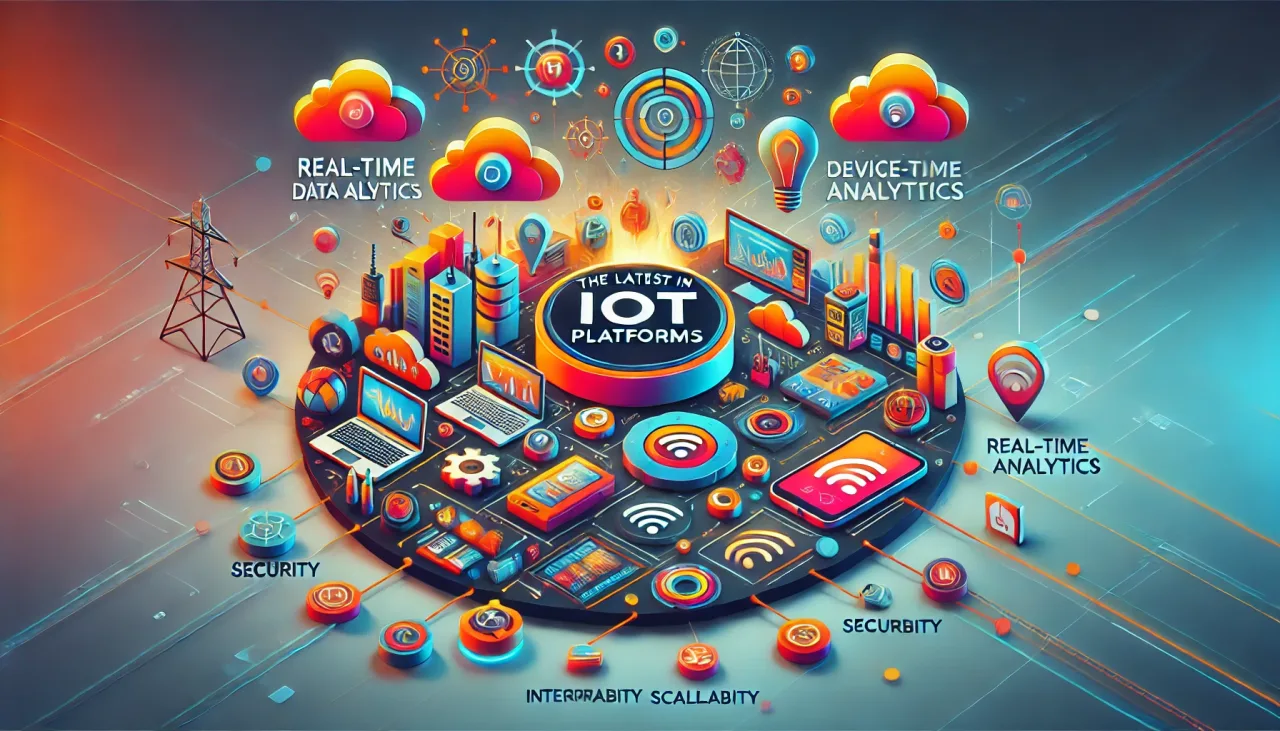In this Article
Introduction
The Internet of Things (IoT) continues to evolve, bringing new advancements and capabilities to IoT platforms each year. As we move into 2024, several trends and innovations are shaping the future of IoT platforms. This detailed guide explores what’s new in IoT platforms for 2024, highlighting key features, emerging technologies, and how they can benefit businesses across various industries.
What are IoT Platforms?
Definition and Purpose
IoT platforms are multi-layered technology solutions that enable the provisioning, management, and automation of connected devices within the IoT ecosystem. They provide the necessary tools and infrastructure to connect, manage, and analyze data from IoT devices, facilitating seamless communication and data flow.
Key Components of IoT Platforms
- Device Management: Tools for onboarding, monitoring, and maintaining IoT devices.
- Data Processing and Analytics: Real-time data processing and advanced analytics capabilities.
- Connectivity Management: Supports various communication protocols for seamless data flow.
- Security Features: Ensures data integrity and device security.
- Application Enablement: APIs and SDKs for developing custom IoT applications.
The Latest Trends in IoT Platforms for 2024
1. Enhanced AI and Machine Learning Integration
Overview
The integration of artificial intelligence (AI) and machine learning (ML) into IoT platforms is becoming more sophisticated in 2024. These technologies enable advanced data analytics, predictive modeling, and automation, making IoT platforms more intelligent and capable.
Key Features
- Predictive Maintenance: Uses AI and ML to predict equipment failures and schedule maintenance proactively.
- Anomaly Detection: AI algorithms identify anomalies in data, helping to detect and mitigate issues early.
- Automated Insights: ML algorithms generate automated insights and recommendations based on data analysis.
Benefits
- Improved Efficiency: AI-driven predictive maintenance reduces downtime and maintenance costs.
- Enhanced Security: Anomaly detection improves security by identifying potential threats.
- Better Decision-Making: Automated insights support data-driven decision-making.
Example: IBM Watson IoT Platform
IBM Watson IoT Platform leverages AI and ML to provide advanced analytics and predictive capabilities. Businesses can use these features to enhance operational efficiency and security.
2. Expansion of Edge Computing Capabilities
Overview
Edge computing is gaining traction in 2024, enabling local data processing and reducing latency. This trend enhances the performance and reliability of IoT platforms, especially for time-sensitive applications.
Key Features
- Local Data Processing: Processes data closer to the source, reducing the need for centralized data centers.
- Real-Time Analytics: Provides real-time data analytics, crucial for time-sensitive applications.
- Scalable Architecture: Supports scalable edge computing architectures, ensuring the platform can handle large-scale deployments.
Benefits
- Reduced Latency: Local data processing reduces latency, improving response times.
- Enhanced Performance: Real-time analytics enhance the performance of IoT applications.
- Scalability: Supports large-scale deployments with edge computing capabilities.
Example: Microsoft Azure IoT Edge
Microsoft Azure IoT Edge extends cloud capabilities to edge devices, enabling local data processing and real-time analytics. This enhances the performance and scalability of IoT applications.
3. Advanced Security Enhancements
Overview
Security remains a top priority for IoT platforms in 2024. New advancements in security technologies are being integrated into IoT platforms to protect data and devices from cyber threats.
Key Features
- Enhanced Encryption: Implements advanced encryption methods to protect data in transit and at rest.
- Zero Trust Architecture: Adopts a zero trust approach, verifying every device and user before granting access.
- Automated Incident Response: Uses AI to detect and respond to security incidents automatically.
Benefits
- Data Protection: Advanced encryption ensures data integrity and privacy.
- Improved Security: Zero trust architecture enhances security by verifying all devices and users.
- Swift Incident Response: Automated incident response reduces the impact of security breaches.
Example: Cisco IoT Security
Cisco IoT Security offers advanced security features, including enhanced encryption, zero trust architecture, and automated incident response, ensuring robust protection for IoT deployments.
4. Greater Focus on Interoperability and Standardization
Overview

Ai Image by Dall-E
Interoperability and standardization are critical for the success of IoT ecosystems. In 2024, there is a greater focus on developing and adopting industry standards to ensure seamless integration and communication between IoT devices and platforms.
Key Features
- Standard Protocols: Supports industry-standard communication protocols for seamless interoperability.
- Open APIs: Provides open APIs to facilitate integration with other systems and platforms.
- Cross-Platform Compatibility: Ensures compatibility with various IoT devices and platforms.
Benefits
- Seamless Integration: Standard protocols and open APIs enable seamless integration with other systems.
- Reduced Complexity: Cross-platform compatibility reduces the complexity of IoT deployments.
- Enhanced Collaboration: Standardization promotes collaboration between different IoT vendors and solutions.
Example: OMA Lightweight M2M (LwM2M)
OMA Lightweight M2M is a protocol standard designed for managing IoT devices. It ensures interoperability and standardization, making it easier to integrate and manage IoT devices across different platforms.
5. Improved User Experience with Enhanced Interfaces
Overview
User experience (UX) is becoming a key focus for IoT platforms in 2024. Enhanced interfaces and user-friendly designs are being implemented to make it easier for users to manage IoT devices and data.
Key Features
- Intuitive Dashboards: Provides user-friendly dashboards for easy monitoring and management.
- Customizable Interfaces: Allows users to customize interfaces to suit their specific needs.
- Mobile Access: Offers mobile-friendly interfaces for managing IoT platforms on the go.
Benefits
- Ease of Use: Intuitive dashboards and customizable interfaces enhance ease of use.
- Flexibility: Customizable interfaces provide flexibility to meet specific user needs.
- Convenience: Mobile access enables users to manage IoT platforms from anywhere.
Example: Particle
Particle offers an IoT platform with an intuitive and user-friendly interface. Users can easily monitor and manage their IoT devices and data through customizable dashboards and mobile access.
6. Integration of Digital Twins
Overview
Digital twin technology is becoming integral to IoT platforms in 2024. Digital twins create virtual replicas of physical assets, enabling real-time monitoring and simulation of their behavior.
Key Features
- Real-Time Monitoring: Provides real-time insights into the performance and condition of physical assets.
- Predictive Maintenance: Uses digital twins to predict maintenance needs and optimize asset management.
- Performance Optimization: Simulates various operating conditions to optimize asset performance and efficiency.
Benefits
- Enhanced Monitoring: Real-time monitoring improves visibility into asset performance.
- Proactive Maintenance: Predictive maintenance reduces downtime and maintenance costs.
- Operational Efficiency: Performance optimization enhances operational efficiency.
Example: GE Digital Twin
GE Digital Twin technology integrates with IoT platforms to provide real-time monitoring, predictive maintenance, and performance optimization for industrial assets.
7. Expansion of IoT Ecosystems
Overview
IoT ecosystems are expanding in 2024, with more devices, applications, and platforms being interconnected. This expansion enhances the capabilities and reach of IoT solutions.
Key Features
- Ecosystem Connectivity: Connects a wide range of IoT devices, applications, and platforms.
- Marketplace Integration: Offers integration with marketplaces for third-party applications and services.
- Collaborative Innovation: Promotes collaboration between different IoT vendors and solutions.
Benefits
- Increased Capabilities: Expanding ecosystems enhance the capabilities of IoT solutions.
- Flexibility: Marketplace integration provides access to a wide range of third-party tools and services.
- Collaborative Growth: Collaborative innovation drives growth and development in the IoT space.
Example: AWS IoT Marketplace
AWS IoT Marketplace connects a wide range of IoT devices, applications, and platforms, providing businesses with access to a vast ecosystem of IoT solutions.
Practical Applications of the Latest IoT Platform Trends
Smart Cities

Ai Image by Dall
IoT platforms are crucial for developing and managing smart city applications. Enhanced AI, edge computing, and interoperability enable real-time monitoring and management of urban infrastructure, improving city services and sustainability.
Healthcare
In healthcare, IoT platforms provide real-time monitoring and management of medical devices and patient data. Advanced security, digital twins, and improved UX enhance patient care and operational efficiency.
Industrial IoT
IoT platforms are transforming industrial operations by providing real-time visibility into machinery and processes. Predictive maintenance, AI integration, and edge computing optimize industrial operations and reduce downtime.
Agriculture
In agriculture, IoT platform help farmers monitor and manage crops and livestock. Enhanced AI, edge computing, and digital twins improve yields and resource utilization.
Future Directions for IoT Platforms
Integration with 5G Networks
The rollout of 5G networks is expected to enhance the capabilities of IoT platforms. 5G offers higher bandwidth, lower latency, and greater capacity, enabling more devices to be connected and more data to be processed in real-time.
Blockchain Integration
It is being integrated into IoT platform to enhance data security and integrity. Blockchain provides a decentralized and tamper-proof ledger, ensuring the trustworthiness of IoT data.
Sustainable IoT Solutions
There is a growing focus on developing sustainable IoT solutions. IoT platform are incorporating energy-efficient technologies and practices to reduce their environmental impact.
Conclusion
IoT platforms are at the forefront of technological innovation, enabling businesses to harness the power of connected devices and data. The latest trends in 2024—enhanced AI and machine learning, expanded edge computing capabilities, advanced security, interoperability, improved user experience, digital twins, and expanding ecosystems—are driving the evolution of IoT platforms. By leveraging these advancements, businesses can optimize their IoT deployments, improve operational efficiency, and drive innovation.
How We Can Help
At Minnovation, we specialize in providing comprehensive IoT solutions tailored to meet the unique needs of your business. Our expertise in the latest IoT platform trends ensures seamless integration, robust security, and enhanced performance. We offer consultation, development, and management services to help you harness the full potential of IoT platforms. Whether you are looking to optimize existing systems or implement new IoT strategies, our team is here to support you. Let us partner with you to drive innovation and achieve your business goals through cutting-edge IoT technology. For more details, visit our site or Contact us.
Reference
Related Blog Posts
How Smart Cities Connect: Getting Started with Edge AI and IoT Technology
How to Get Started with Edge AI and IoT Technologies in Smart Cities: Overcoming Integration Challenges In recent years, the concept of smart cities has evolved from a futuristic Read More
5 Step Strategy: Ensuring Security and Privacy in 15-Minute Smart Cities
Introduction Ensuring security and privacy in 15-minute smart cities is a critical challenge as urban areas become increasingly connected through IoT and edge AI technologies. These cities aim to Read More
What is a smart city and the challenge of legacy systems
How to Get Started with Integrating Legacy Systems in Smart Cities Smart cities are transforming urban landscapes by leveraging technology to improve the quality of life for residents. However, Read More




